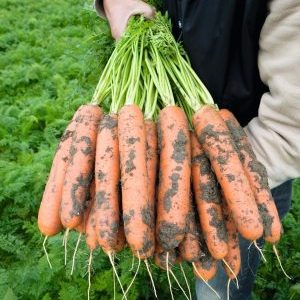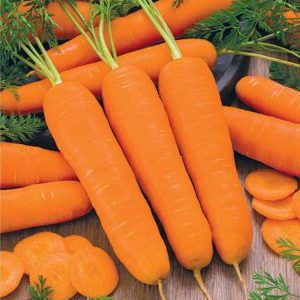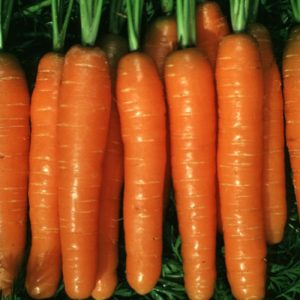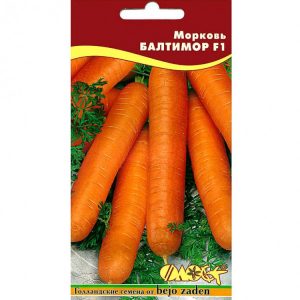High-yielding first-generation carrot hybrid: Baltimore f1
Holland breeders are known for their developments all over the world. The seeds they create are characterized by a high percentage of germination, resistance to various diseases, excellent taste of the fruits obtained, and high yield rates.
One of the famous representatives of the Bejo breeding company is the Baltimore F1 carrot. In the article, we will consider what its main features and advantages are.
The content of the article
Description of hybrid carrot Baltimore f1
Root crops are cone-shaped with a rounded tip. Their length is 22-25 cm, diameter is 3-5 cm, weight is 200-220 g. The skin is smooth, thin, of bright orange hue. The pulp is not friable, homogeneous, juicy, the core is thin. The hybrid has powerful dissected leaves. The tops reach a height of 40 cm.
Origin and development

Baltimore F1 carrots are bred by the Dutch breeding company "Bejo". The hybrid belongs to the extensive Berlikum / Nantes varietal group. The selection was based on the Nandrin F1 variety.
Scientists have perfected the original variety by crossing it with others. As a result of this work, the palatability has improved, and the resistance of the tops to diseases has increased.
Baltimore F1 is a first generation hybrid. The seeds obtained from it will give a weak harvest of carrots. Therefore, the seed must be purchased in stores.
Chemical composition and useful properties
100 g of carrots contain: fructose 8-9.5%, dry matter 11.6-12.4%, beta-carotene 23.7 mg. The energy value of one fruit is 26 kcal.
The content of macronutrients in fruits:
- potassium - 200 mg;
- calcium - 27.6 mg;
- phosphorus - 57 mg;
- magnesium - 39.1 mg;
- sodium - 20.4 mg.
Microelement content:
- iron - 740 mg;
- zinc - 420 mg;
- aluminum - 330 mg;
- manganese - 215 mg;
- boron - 205 mg;
- vanadium - 100 mg;
- copper - 82.2 mg;
- fluorine - 53.7 mg;
- molybdenum - 21.6 mg.
Vitamins composition:
- A - 9.2 mg;

- B1 - 0.06 mg;
- B2 - 0.07 mg;
- B8 - 29.3 mg;
- B9 - 0.1 mg;
- C - 5.8 mg;
- PP - 1.2 mg;
- E - 0.9 mg.
Carrots have always been used as an adjunct to drugs for the treatment and prevention of various diseases.
The vegetable is useful for diseases of the heart, gastrointestinal tract, anemia, pneumonia, bronchial asthma, pyelonephritis.
Carrot juice normalizes acidity in gastritis, increases appetite, neutralizes the effect of antibiotics on the body, and improves vision.
Ripening period
A medium-ripening hybrid. From the moment of germination to harvest, it takes 90-100 days.
Yield
The performance of the hybrid is high. The yield per hectare with proper cultivation techniques is 335 - 605 centners.
Disease resistance
The hybrid is resistant to fungal infections, powdery mildew. But the culture is often affected by dry, white and gray rot.To prevent diseases, potash fertilizers are introduced into the soil, and the tops are treated with a Bordeaux mixture.
Characteristics, appearance and taste
The hybrid is mid-ripening, ripening about a hundred days. It tolerates temperature changes well.
Baltimore has well-developed tops, up to 60 cm high. This allows harvesting with mechanized equipment on large areas.
The leaves of the tops are carved, deep green, with a noticeable waxy coating. The stem is light green, slightly thickened.
The hybrid roots look attractive: they have an even cylindrical shape with a rounded tip. Fruits are approximately the same size, length - 22-25 cm, weight - 200-220 g, diameter at the base - 3-4 cm.
The skin is thin, color from orange to dark orange. The core is thin, does not separate from the pulp.
The taste of the hybrid is excellent. The root vegetables are juicy, crunchy, sweet and firm. They are used for baby and diet food.
Which regions is best suited for
Due to its fast ripening time and excellent frost resistance, Baltimore F1 is grown even in the northern part of Russia.
The hybrid is suitable for growing in the Central, North-West, West and East Siberian, Far East, Volgo-Vyatka, Nizhnevolzhsky and Uralsky regions. The best yield indicators are in the Central region of Russia.
The main advantages and disadvantages of a hybrid
Main advantages:
- high sugar content, which gives a sweet taste to the fruit;
- juiciness of fruits;
- high carotene content;
- increased resistance to cold and temperature changes;
- resistance to long-term transportation and high keeping rates.
Disadvantage: Seeds must be purchased from garden centers or online stores.
What is the difference from other varieties:
- root crops are even, approximately the same size;
- the hybrid is more resistant to many diseases and pests;
- the possibility of harvesting with mechanized equipment;
- tolerates long-term storage.

Features of planting and growing
Carrots are considered an unpretentious crop to grow, but the necessary agrotechnical conditions for the full growth of root crops must be observed.
Preparing for landing
For growing carrots, sunny areas are chosen. The preparation of the land plot is carried out two weeks before sowing. Wood ash and humus are added to the soil. The site is dug up, leveling the surface, removing weed residues, compacted parts of the soil, stones.
Ground requirements
Crop beds are located on loose, air-permeable soils. Slightly acidic and neutral soils, sandy and sandy loam soils are well suited.
If there is black earth, clay and loamy soil on the site, sand and peat must first be added to it. In dense soil, it is difficult for vegetables to get out of the soil layer; they will grow in an irregular, gnarled shape.
Predecessors
Experienced gardeners pay great attention to the question of which vegetables grew on the site before carrots were planted on it. It is believed that the best predecessors are tomatoes, cabbage, cucumbers, onions.
Timing, scheme and landing rules
Carrots are sown in early March or October. For planting seeds, choose a light, drained soil. The plot must be sunny. It is not recommended to plant vegetables in the shade of tall trees.
First, rows are formed at a distance of 18-20 cm from each other. Then grooves are made with a depth of 2-3 cm.Seeds are placed in 3-5 pieces every 4-5 cm.
In order for the root crops to grow even, not deformed, they make high beds. The thickness of the soil layer should correspond to the length of the future vegetable and not exceed 23-25 cm. The beds require regular fluffing.
If sowing is carried out before winter, it is performed in November, after the onset of stable cold weather, so that premature germination of seeds does not occur.
The seeds are covered with dry soil. After that, the beds are sprinkled with peat with a layer of 2-3 cm.
When snow falls over the beds, snowdrifts are formed for insulation. With the onset of spring, excess snow is removed. When the snow melts, the soil is naturally moistened.
The gradually warming soil is carefully loosened so as not to damage the seedlings.
Growing features
To accelerate germination, seed material is soaked in clean warm water for 24 hours before sowing.
When growing a crop, it must be borne in mind that at first, carrots grow slowly. Weeds are ahead of her in growth, while oppressing young shoots. Therefore, all weeds are carefully removed before sowing. Subsequently, during the growing season, it is necessary to remove weeds in time.
Important! It is impossible to allow the formation of an earthen crust that interferes with the appearance of young growth. The crust must be destroyed with a rake and other gardening equipment.
The nuances of care
Since the seeds were planted in several pieces, they germinate in different sizes. Weaker shoots are removed. When weakened seedlings are removed from the soil, the root system of the remaining shoots can be disturbed, so this is done with caution.
After thinning, the beds are watered to restore the growth of the remaining seedlings.
Watering mode
The first watering is carried out a week before planting the seeds in the soil. It is needed to facilitate seed germination.
reference... Watering before sowing is carried out with the addition of potassium permanganate to the water. This will protect the seedlings from pathogenic microorganisms in the soil.
After sowing, the beds are watered with a drop method so that the pressure of water does not wash the seeds out of the soil. In dry weather, they are covered with a transparent film before seedlings emerge.
After their appearance, watering is carried out once every 5 days, depending on weather conditions. Water stagnation should not be allowed - this will destroy the fragile roots.
During the formation of root crops, the frequency of watering is reduced to once every 8-10 days, but more water is consumed. The soil should be moistened to a depth corresponding to the length of the fruit.
Attention! Watering of the crop is stopped 15-20 days before the start of harvesting.
Thinning and weed control
The first thinning is carried out 10-12 days after the emergence of the shoots. When it thickens, weak specimens are removed, and a gap of 2 cm is maintained between the remaining ones.
The second thinning is performed when five leaves appear in plants. The recommended distance between them is 5-6 cm.
Weeds are removed during thinning. This is necessary so that they do not interfere with the growth of culture.
Top dressing
The taste characteristics of the fruits depend on the introduced nutrients, microelements during the growing season. Top dressing is carried out three times per season.
Before sowing, nitrogen and phosphorus fertilizers are applied and the soil is dug up.
Potash dressings are used during the formation of root crops. It is advisable to add potassium to the soil in the form of liquid solutions. Potassium chloride is not used - the action of chlorine inhibits plant growth.
It is not recommended to use fresh manure - root crops will grow irregularly shaped, and their shelf life will decrease.
Important! Top dressing is applied after moistening the soil.
For the first feeding, the following composition is prepared: 25 g of ammonium nitrate, 30 g of superphosphate, 30 g of potassium sulfate are diluted in 10 liters of water.
The second feeding is carried out 20 days after the first with the same composition.
For the third feeding, nitrogen is not used.
Disease and pest control
The culture is often affected by such diseases:
- Dry rot - phomosis, a fungal disease, during which the aerial part (tops) is first affected, then the roots. Its development is stimulated by unremoved plant residues. To prevent disease, potash and phosphorus fertilizers are applied to the soil.
- White rot. Signs of its appearance are the softening of the root crop with the appearance of a white fluffy bloom. Potash dressings, insecticides with copper content help to combat it.
- Gray rot - fungal infection of fruits.To eliminate it, nitrogen fertilizing is introduced into the soil. Plants are treated with a 1% solution of Bordeaux liquid.
Carrot fly is isolated from pests. Its larvae develop in the ground, feeding on root crops. In the fight against it, drugs "Actellik", "Decis Profi", "Sharpei" are used. Regular weeding with weed removal is required.
Harvesting and storage
Harvesting begins in the second half of September. Dig the fruits in dry weather. It is necessary to wait for the onset of cool days, since the difference in temperature - warm air outside and cold air in the cellar - will negatively affect the storage of the crop.
How and when to collect

When the air temperature drops to + 5 ° C, the growth of vegetables stops. At this time, the harvest begins. Before digging, the beds are moistened - to facilitate the extraction of carrots.
Since the tops of the hybrid are high and powerful, mechanized techniques are used for large volumes. The extracted fruits are carefully peeled off the ground and the tops are removed.
Storage features and keeping quality of the hybrid
The harvested carrots are dried for several days on a dry surface. Then they start sorting... Damaged fruits are discarded to avoid rotting other vegetables.
The crop is transferred to a vegetable store. Optimal conditions for storing fruits: maintaining a temperature of -1-2 ° C and high humidity - 85-95%.
The hybrid has excellent keeping quality - 90-95%. If all conditions are met, the harvest is stored until spring.
Read also:
An early ripe, cold-tolerant hybrid of Dordogne carrots.
Late ripe table carrot hybrid Bolero f1.
Juicy and sweet hybrid of carrots Abaco F1 with a high yield.
What can be the difficulties in growing
The culture is demanding on growing conditions. On heavy, dense soils, root crops will be severely deformed.
With a lack of light, plants will grow weak.
If you skip the harvesting period for early carrots, they often crack in the ground, lose all their juiciness and, as a result, taste.
Great importance is attached to the irrigation of crops. If the carrots are not watered for a long time, and then water abundantly, the fruits will crack.
Important! It is necessary to constantly loosen the soil and remove the soil crust in time.
Tips from experienced gardeners
Experienced gardeners recommend not to leave root crops for storage, even with minor signs of rot - hoping that it will disappear when dried. Rot will not only remain, but will also move to healthy fruits.
Also, vegetable growers advise to pre-disinfect containers for storing crops.
Gardeners do not recommend frequent and shallow watering - it is better to water abundantly, twice a week.
Reviews
Consider the reviews of real summer residents about Baltimore F1 carrots.
Svetlana, Saratov: «A salesperson in the seed department advised me to try the Baltimore F1 carrot hybrid. I liked the harvest. Carrots are smooth, without cracks. The taste is very pleasant, crispy and sweet. The grandchildren were happy. "
Vladimir, Moscow: “A neighbor on the site advised the carrot seeds he tested Baltimore f1. I tried sowing seeds at the end of October. Most of them sprouted in the spring. I liked the quality of the fruit.
Elena, Pskov: “I planted two varieties of carrots on the site. Baltimore f1 tasted better. It is much sweeter, juicier. The fruits are beautiful, even, approximately the same size. I will plant more. "
Conclusion
The Baltimore f1 carrot hybrid is considered easy to grow, produces a high yield, ideal for long-term storage. It is in high demand among amateur summer residents.
The excellent quality of root crops allows us to assert that the hybrid of the Dutch selection Baltimore F1 is undoubtedly one of the best. Try to plant it on your site, and see for yourself of its merits.